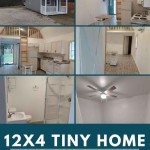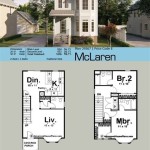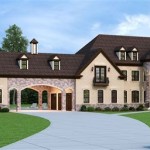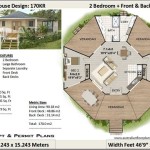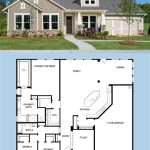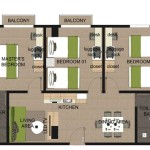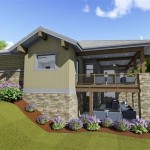House Plans With In-Law Suite: A Comprehensive Guide
The decision to invest in a home is a significant one, often involving careful consideration of present and future needs. One growing trend that addresses multigenerational living or the desire for rental income is the incorporation of an in-law suite into a house plan. These suites, also referred to as accessory dwelling units (ADUs) or granny flats, offer self-contained living spaces within or attached to the main residence. Choosing a suitable house plan with an in-law suite necessitates understanding various design considerations, legal implications, and potential benefits.
In-law suites provide a degree of independence for occupants while maintaining proximity to family or allowing homeowners to generate rental income. They can be vital in supporting aging parents, providing a haven for adult children returning home, or accommodating caregivers. Properly designed, these suites can improve a home's value and adaptability, making them a desirable feature for many buyers.
Key Considerations When Choosing a House Plan
Selecting a suitable house plan with an in-law suite involves a careful assessment of several factors. This includes space requirements, privacy concerns, accessibility needs, and budgetary constraints. Each of these aspects plays a crucial role in ensuring the in-law suite meets the needs of its occupants and integrates seamlessly with the main residence.
Space and Layout: The size and layout of the in-law suite are paramount. The suite should include essential living areas such as a bedroom, bathroom, living room, and kitchenette. The dimensions of each space should be adequate for comfortable living and mobility. The layout should allow for efficient use of space and provide a sense of privacy and independence. Open-concept designs can maximize space, while clearly defined areas can delineate living zones.
Privacy and Accessibility: Maintaining privacy for both the main residence and the in-law suite is essential. Separate entrances are highly desirable, providing occupants with a sense of autonomy. Strategic placement of windows and doors can minimize noise and visual intrusion. Accessibility is another critical consideration, especially if the suite is intended for elderly or disabled individuals. Features such as wider doorways, grab bars in bathrooms, and ramp access should be incorporated to ensure safety and ease of movement.
Integration and Separation: The degree of integration between the main residence and the in-law suite is an important design decision. Some homeowners prefer a completely separate unit with its own utilities and entrance. Others opt for a more integrated design, with shared common areas such as the laundry room or backyard. The level of integration should be carefully considered based on the needs and preferences of the occupants.
Budget and Construction: The cost of building an in-law suite can vary widely depending on the size, complexity, and finishes. It is essential to establish a realistic budget and obtain quotes from multiple contractors. Consideration should be given to the cost of materials, labor, permits, and utility connections. It is also important to factor in potential cost overruns and unexpected expenses. A well-defined budget helps manage expectations and ensures the project stays within financial reach.
Types of In-Law Suite House Plans
House plans with in-law suites come in various configurations, each offering distinct advantages and disadvantages. The choice of plan depends on the available space, budget, and desired level of integration with the main residence. Common types include attached suites, detached suites, and basement conversions.
Attached In-Law Suites: These suites are connected to the main house, typically sharing a wall or roofline. They may have a separate entrance or a connecting door to the main residence. Attached suites offer convenience and accessibility, allowing for easy interaction between occupants. They are often less expensive to build than detached suites, as they can share utilities and structural elements with the main house. However, attached suites may offer less privacy than detached options.
Detached In-Law Suites: Also known as detached accessory dwelling units (DADUs), these suites are separate structures located on the same property as the main house. They offer maximum privacy and independence for both occupants. Detached suites can be customized to meet specific needs and preferences, and they can potentially be rented out as separate units. However, they are typically more expensive to build than attached suites, as they require separate foundations, utilities, and roofing.
Basement Conversions: Converting an existing basement into an in-law suite can be a cost-effective option, especially if the basement is already partially finished. Basement conversions can provide a comfortable and private living space. However, they may require significant renovations to ensure proper insulation, ventilation, and egress windows. It is also important to address any moisture issues and ensure the basement meets all building codes.
Above Garage Apartments: Building an apartment above a detached garage can be another viable option for creating an in-law suite. This configuration offers privacy and separation from the main house without requiring additional land. Above-garage apartments can be accessed via an exterior staircase. Considerations should include structural support for the garage, insulation, and soundproofing to minimize noise transmission to the main house.
Legal and Regulatory Considerations
Constructing an in-law suite often involves navigating local zoning regulations, building codes, and homeowners association rules. It is essential to research these regulations thoroughly before beginning any construction work to avoid potential legal issues and ensure compliance.
Zoning Regulations: Zoning regulations dictate the types of structures that are permitted on a particular property. Many jurisdictions have specific rules governing accessory dwelling units (ADUs), including size restrictions, setback requirements, and parking regulations. It is crucial to check with the local planning department to determine what regulations apply to in-law suites in the area.
Building Codes: Building codes establish minimum standards for the construction and safety of buildings. In-law suites must comply with all applicable building codes, including requirements for fire safety, electrical wiring, plumbing, and ventilation. Hiring a qualified architect or contractor who is familiar with local building codes is essential to ensure compliance.
Permitting Process: Obtaining the necessary permits is a crucial step in the construction process. Permits are required for various aspects of the project, including building, electrical, plumbing, and mechanical work. The permitting process can be complex and time-consuming, so it is important to start early and follow all instructions carefully.
Homeowners Association (HOA) Rules: If the property is located in a community with a homeowners association, it is essential to review the HOA rules and regulations regarding in-law suites. Some HOAs may have restrictions on the size, design, or use of ADUs. Obtaining approval from the HOA before starting construction is crucial to avoid potential fines or legal action.
Rental Regulations: If the in-law suite is intended for rental purposes, it is essential to comply with all applicable rental regulations. This may include obtaining a rental license, meeting minimum housing standards, and complying with fair housing laws. It is also important to understand the rights and responsibilities of landlords and tenants in the jurisdiction.
Impact Fees and Property Taxes: In some jurisdictions, the construction of an in-law suite may trigger impact fees or property tax increases. Impact fees are one-time charges assessed by local governments to offset the cost of increased demand on public services, such as schools and infrastructure. Property taxes may increase due to the added value of the in-law suite. Consulting with a local tax assessor can help determine the potential financial impact of adding an in-law suite.
By carefully considering these legal and regulatory aspects, homeowners can ensure that their in-law suite project complies with all applicable laws and regulations, avoiding potential legal issues and ensuring a smooth construction process.
Design Elements for Enhanced Functionality
Effective design elements can substantially enhance the functionality and appeal of an in-law suite. Careful consideration should be given to layout, storage, lighting, and universal design principles to create a comfortable and accessible living space.
Open-Concept Layouts: Open-concept layouts can maximize space and create a sense of openness in smaller in-law suites. Combining the living room, dining area, and kitchenette into a single open space can make the suite feel larger and more inviting. This design also promotes social interaction and allows for flexible use of space.
Ample Storage Solutions: Adequate storage is essential in any living space, especially in compact in-law suites. Incorporating built-in storage solutions, such as shelving, cabinets, and closets, can help minimize clutter and maximize space. Vertical storage options, such as tall cabinets and shelving units, can also be effective in utilizing vertical space.
Strategic Lighting Design: Proper lighting can significantly enhance the ambiance and functionality of an in-law suite. Natural light should be maximized by incorporating large windows and skylights. Artificial lighting should be carefully planned to provide adequate illumination for various tasks and activities. Layered lighting, including ambient, task, and accent lighting, can create a warm and inviting atmosphere.
Universal Design Principles: Universal design principles aim to create spaces that are accessible and usable by people of all ages and abilities. Incorporating universal design features into an in-law suite can make it more comfortable and convenient for occupants of all ages. This may include features such as wider doorways, lever handles, grab bars in bathrooms, and adjustable-height countertops.
Soundproofing Measures: Soundproofing can help minimize noise transmission between the in-law suite and the main residence. Installing soundproofing insulation in walls and ceilings, using solid-core doors, and sealing gaps around windows and doors can significantly reduce noise levels. This is especially important if the in-law suite is located near a busy street or a noisy area of the main house.
Energy-Efficient Features: Incorporating energy-efficient features can help reduce utility costs and minimize the environmental impact of the in-law suite. This may include installing energy-efficient windows and doors, using high-efficiency appliances, and adding insulation to walls and ceilings. Solar panels can also be a viable option for generating renewable energy and reducing reliance on the grid.

Southern Style House Plan With In Law Suite

In Law Suite Plans Give Mom Space And Keep Yours The House Designers

House Plan 65862 Tuscan Style With 2091 Sq Ft 3 Bed 2 Bath 1

Exquisite Mountain Modern Home Plan With In Law Suite And 4 Car Garage 95104rw Architectural Designs House Plans

Modern Farmhouse Plan With In Law Suite 70607mk Architectural Designs House Plans

House Plans With In Law Suites Houseplans Blog Com

One Story With In Law Suite Plan 2286

Front Side View House Plans With A Separate In Law Suite

Cape Cod House Plans With Inlaw Suite Best Of Mother In New Multigenerational Country

Homes With Mother In Law Suites
Related Posts

